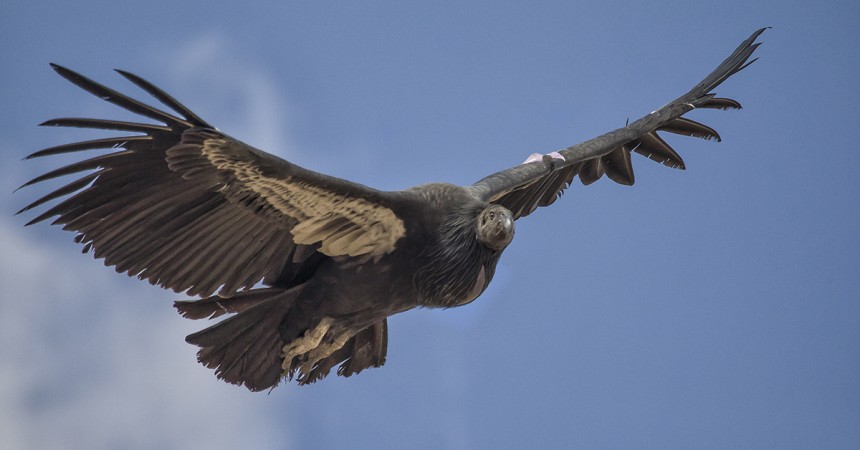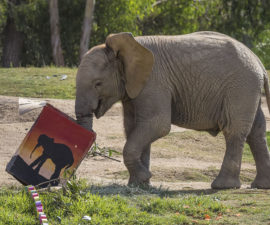We have switched the camera view of the San Diego Zoo Safari Park’s Condor Cam. Our faithful viewers have been able to watch our California condor chick, Antiki, hatch and grow in her nest box, but now they can view her out in her flight pen with her parents, father Sisquoc and mother Shatash, because she’s taken the next exciting step in her development—Antiki has fledged!
Fledging is the process in which a young bird leaves the nest. We consider a California condor chick to be fledged when they can fly to the higher perches in the pen—approximately 10 feet off the ground. When condor chicks fledge, they tend to be around 140 or 150 days old. The youngest bird to fledge here at the Safari Park was 123 days old. Antiki flew for the first time at 156 days of age.
Our condor nest boxes are elevated; they’re on the second floor of the condor breeding facility. The nests have one entrance that leads to the roost area. The entrance has an 18-inch barrier at the base to prevent young hatchlings from wandering out of our camera’s view. This barrier also provides exercise for the chick when it is big enough to start jumping up onto the barrier. The roost area is open to the flight pen and has a ledge that is about eight feet off of the ground. There is a five-inch-diameter pole leaning from the ground to the ledge; we call this the “pole ladder.” The condors can walk up or down this pole ladder to get to or from the nest. They can, of course, fly to the nest as well if they desire.
For a few weeks, Antiki was able to walk down the pole ladder to start exploring the flight pen. She would watch Sisquoc and Shatash eat, sometimes begging for them to feed her, sometimes playing tug-of-war trying to take food from them. She also got to drink from the pool for the first time. She would climb up onto an eight-foot-tall stump perch and up into the olive tree in the pen. She started to spend the night out in the pen, perched up in the tree, under the watchful eyes of her parents.
We still had not seen her actually fly to any of the perches, though, until September 13. That morning, after being warmed by the sun, she took a short flight from the olive tree to join Sisquoc on one of the 10-foot-tall perches. After that, she could deftly fly from perch to perch like a pro! Since that morning, Antiki spends the majority of the time out in the pen, sometimes returning to sit in the shade of the roost.
When condor chicks fledge in the wild, it can be a long process as well. They will often walk around the mouth of their nest cave, hopping about, testing their wings. They may hop or climb into nearby shrubs or trees to get a better vantage point. Very seldom do chicks just spring forth from their nest into the wild blue yonder. They usually need to exercise and develop their abilities before embarking on such a dangerous venture. Mom and dad are always present to escort or protect the chicks. Parent condors can be very vigilant and defensive of their chicks. After all, much energy and many resources went into producing just this one chick, so they try very hard to ensure success for their only nestling. One pair of condors in California actually chased a black bear away from their nest!
With this new camera view, you’ll be able to see the roost area, most of the perches in the pen, the feeding area (shift pen), shade areas created by plants, and the pool. The view is wide, so detail is a bit harder to discern. Also, we do minimal maintenance in the pen, so the pen has lots of plant growth and dried food (animal carcasses) in it. We limit our activities in/near chick pens so as not to expose Antiki to humans, thus desensitizing her to our presence. We have found that chicks raised in isolation from humans tend to be more successful once they are released to the wild. The flight pen won’t look as nice as an exhibit you might see at the Safari Park or the Zoo, but Sisquoc and Shatash prefer it that way, if it means we stay away from their precious chick!
If, by chance, you don’t see Antiki out in the pen, she could be resting in the shade of the roost, or she may have hopped back into the nest box. This is completely normal. The adult condors do the same thing. Just give her a little time; she’ll come back out into view later. We have a great volunteer staff that moves the camera for the nest box view, but we keepers move the camera when it is the pen view. We’ll do our best to zoom in to give you a good view of her when we can, but we are not always near the camera controls as we are also taking care of the other condors.
So what’s next for Antiki? She’ll stay in the pen with her parents for a little while longer. She is still learning from them. In the wild, condor chicks stay with or around their parents for up to 18 months. We don’t let them stay that long here at the Park. If we did, the next breeding season would probably be compromised; the presence of the fledgling may prevent the parents from breeding the next year, or the parents may act aggressively towards the chick if they try to nest again. Sometime in this fall, Antiki will be removed from her parents, so they can prepare for the next breeding season. She will be introduced to other birds her age in a group with an adult bird that acts as a behavioral mentor. In the meantime, it will be decided whether she will be a candidate for release to the wild (and where) or held for the captive breeding program. I’ll keep you informed when this happens. Until then, please continue to keep checking in on our big girl.
Everyone’s interest and enthusiasm over the hatch and growth of Antiki have been wonderful. We really appreciate all of the comments and questions we have received throughout her development. Thanks again for all of your support—we couldn’t do it without you!
Ron Webb is a senior keeper at the San Diego Zoo Safari Park. Read his previous blog, One Step Closer to Fledging.






